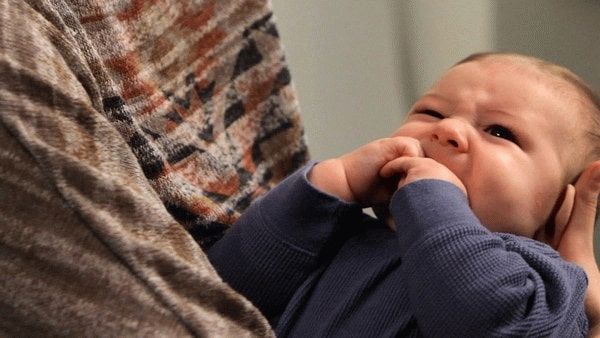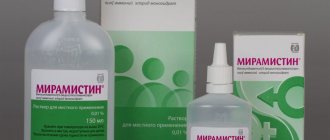Consequences of thrush during lactation
The reasons for the appearance of thrush in nursing mothers are given above; it does not hurt to learn about the consequences of an advanced disease. Thrush causes complications such as infection of the child, candidiasis of the nipples and the mother’s refusal to breastfeed.
Candidiasis appears more often on the nipples due to neglect of hygiene rules. The humidity created by breastfeeding provides an ideal environment for fungi to spread. When the nipples are affected, they acquire a shiny red color and cracks appear. While feeding the baby, the woman begins to experience severe pain, which forces her to stop feeding for a while. The milk may change consistency and pain may appear in the chest.
Due to nipple candidiasis, the infection can penetrate into the baby's mouth. With thrush, the mucous membrane of a baby’s mouth becomes covered with whitish films that cause pain.
Against this background, the baby overheats, he becomes restless and refuses to latch on to the breast. If measures are not taken, the child is deprived of the main nutrition - mother's milk.
Doctors advise mothers to carefully maintain hygiene during lactation. After feeding, the breast is dried open for about 5 minutes, and before feeding, the nipple is wiped with a cotton pad soaked in boiled water. Such preventive measures can prevent the development of thrush on the nipples and infection of the baby.
How to use suppositories correctly
In order for the treatment to be effective and safe during breastfeeding, suppositories for thrush must be used correctly, following a number of simple rules:
- Before inserting the suppository and immediately after it, you should thoroughly wash your hands using antibacterial agents;
- the intimate area should also be washed well with soap or hypoallergenic foam for hygiene;
- during insertion of the suppository, it is better to take a lying position, relax and insert the suppository deep into the vagina;
- when using a disposable applicator, it should be thrown away, and a reusable applicator should be rinsed thoroughly to avoid recurrence of infection;
- after administering the suppository, it is recommended to lie down for at least half an hour so that it has time to dissolve and begin to act at the site of inflammation;
- suppositories tend to dissolve and leak out if a woman is in a standing position, so it is better to insert them into the vagina before bed.
Important! Also, the basic rules for using suppositories during breastfeeding include compliance with the dosage recommended by the doctor. If a specialist has prescribed one suppository per day, there is no need to double the dose in the hope of a speedy recovery. This can provoke the development of side effects in the baby due to the penetration of the active substances of the medication into the milk.
What are the benefits of suppositories against fungus during breastfeeding?
The first thing a doctor focuses on when looking at the list of medications for candidiasis is safety for the child. Tablets and capsules for thrush taken orally can harm the baby's health, since he receives everything that she eats from the mother's milk.
If there is a special need, feeding is suspended for a while until the mother recovers from the fungus. At this time, artificial breast milk substitutes are selected that will not cause colic and indigestion for the baby.
If you temporarily stop breastfeeding, the mother may lose milk or develop mastitis. Suppositories for thrush during lactation are becoming the best option that can cure the mother and not harm the child.
Benefits of using candles
If the problem occurs during lactation, doctors consider suppository medications to be the most effective for thrush during breastfeeding. You should not ignore the problem, because without proper hygiene rules it is easy to transmit a fungal infection to your baby.
The main advantage of using suppositories is local application. The active substances of the suppositories act directly at the site of inflammation, without penetrating into the general bloodstream and without causing adverse reactions on the part of the child’s body. A woman breastfeeding does not need to worry about changes in the composition of her milk.
Also, the use of suppositories does not require additional therapeutic measures; as a rule, after a course of treatment prescribed by a doctor, the signs of thrush quickly disappear. Modern anti-yeast drugs are highly effective and easy to use. Therefore, during the breastfeeding period, a woman will not have problems eliminating the unpleasant symptoms of the disease.
Suppositories are the most effective and safe in the treatment of thrush
Thrush medications for nursing mothers
There are drugs that require giving up breastfeeding, and those that allow the mother to remain on breastfeeding. The first include the following suppositories: Ruvidon, Livarol, Polygynax, Betadine, Ginocaps. The second group of drugs is used without giving up breastfeeding, these are Clotrimazole, Hexicon, Zalain, Pimafucin suppositories.
Despite the fact that they are considered safe for infants, each medicine has limitations and contraindications. You should not self-medicate; the doctor prescribes the drug individually in each case. Below are recommendations for approved medications.
Clotrimazole for thrush
The suppositories contain Imidazole, which is not capable of penetrating into the blood through mucous membranes. As prescribed by a doctor, suppositories are used for a week, twice a day. You need to remain in a lying position until the suppository dissolves inside the vagina.
Hexicon for fungus during hepatitis B
The active ingredient is an antiseptic. Candles are used both during pregnancy and during breastfeeding. The doctor will determine how many days you need to treat thrush with Hexicon, but the average duration of therapy is up to 10 days. Judging by the reviews of patients, mild thrush could be removed within a couple of days of use.
Suppositories are administered every day, 1-2 times. It is better if you manage to remain in a horizontal position for an hour after inserting the suppository. Hexicon spreads well throughout the vaginal mucosa, is active after fungus, and does not affect the vital activity of beneficial lactobacilli and does not disturb the microflora.
Zalain during feeding
The main active ingredient in suppositories is Sertoconazole. It inhibits the growth of fungi by destroying their colonies. The candle is used once before bedtime. The next day, heavy vaginal discharge may appear. You should not wash them; you can use panty liners. The discharge will go away after a couple of days, you should not be afraid of it, this is a normal condition. After a week, if there is a recurrence of thrush, Zalain can be used again, but no more than 2 suppositories within a month.
Pimafucin suppositories for thrush
The action of Pimafucin is aimed at destroying the cell membranes of fungi. The drug contains the antibiotic Natamycin, which is active against fungi. It acts on the mucous membrane without being absorbed into the body. Suppositories are prescribed in a course of 3-6 days. No contraindications or adverse reactions were identified.
Harm to baby
When breastfeeding, only a doctor should prescribe suppositories for candidiasis, since a large number of medications contain substances that can end up in a woman’s blood and in her breast milk. Together with mother's milk, such components can enter the child's body and cause:
- allergic reactions;
- poisoning;
- digestive disorders;
- developmental delay.
Some medications also affect the lactation process, reducing its activity, as a result of which the baby does not receive the required amount of nutrition.
A breastfeeding baby may refuse to suckle due to the mother's use of suppositories that affect the characteristics of the milk, changing its taste and reducing its nutritional quality.

The use of suppositories for thrush while breastfeeding is allowed in case of an actively developing infection. If a woman notices primary signs of pathology, she can use folk recipes to eliminate it.
Traditional recipes for fungus when feeding
In addition to medications, traditional medicine recipes can be used against fungus. Don't assume that natural remedies are harmless.
Plants can harm both mother and baby. Other plants affect lactation.
Before choosing a folk remedy for fungus, you need to consult a doctor. Popular treatment methods are listed below.
Baking soda is a simple and affordable way to get rid of fungus. You need to mix 2 tsp. soda and 0.5 liters of warm water. The resulting solution is used to wipe off areas affected by the fungus, including nipples. Baking soda will relieve itching and reduce redness. After washing the nipples with a soda solution, you need to wait for it to dry, and then apply a nourishing cream.
Chamomile infusion is an inexpensive cure for thrush. You need to place 2 tsp in a bowl. chamomile flowers and pour 0.5 liters of boiling water. The solution is infused for half an hour, filtered, and cooled. Used to wash fungus-affected areas several times a day.
Tea tree oil is added to water when taking a bath. 2 drops are enough to relieve the symptoms of thrush. Allergy sufferers should be careful as tea tree may cause an unpleasant reaction.
Green tea for thrush is consumed orally. In addition to the fact that the drink will remove excess yeast from the body, it will relieve discomfort. Green tea also enhances lactation.
Should I stop feeding?

So that there is no need to wean the baby from the breast, especially if we are talking about a newborn baby. But the use of the suppositories described above is possible more in the initial stages of a fungal infection. If the inflammation has gone far, the nursing mother does not follow the rules of treatment with suppositories, or even with proper therapy the disease returns again - additional measures are required. For example, prescribing antibacterial, antifungal and anti-inflammatory drugs orally. But here, most doctors recommend interrupting feeding until recovery, so as not to harm the baby.
How to promptly recognize candidiasis
Symptoms of thrush are the same for all women – pregnant or not. The first sign is discomfort in intimate places after sex. Often this is a burning sensation, a feeling of tightness that intensifies when the bladder is emptied.
The second symptom indicating the progress of the disease is itching. Unpleasant sensations appear in the area of the labia minora and labia majora. They weaken after hygiene procedures, but appear after a couple of hours.
An obvious sign of thrush is a change in the nature of vaginal discharge. In pregnant women, they become thicker than usual and cloudy. With candidiasis, white inclusions can be detected among the mucus. They are similar to curdled milk (hence the name “thrush”). The secret comes out in increased volume. Severe itching is accompanied by thick, lumpy vaginal discharge. An unpleasant sour-milk odor appears in intimate areas.
Thrush may also have less severe symptoms. Some women periodically experience itching and burning with scanty discharge. Their consistency is thick, but there are no curdled inclusions. These are manifestations of chronic thrush, which a woman could have had even before pregnancy.
Any set of symptoms similar to vaginal candidiasis should be contacted by your obstetrician-gynecologist. The specialist will conduct an examination and take swabs. Based on the test results, it will be possible to say exactly what the nature of the unpleasant sensations in the expectant mother is. Delay is not only discomfort for the pregnant woman, but also poses a threat to the fetus.
Reviews from moms
Yulia, 23 years old: For me, the best remedy for thrush is Hexicon suppositories. My friends scared me that any medications would get into my milk; they said it was better to stop breastfeeding. But the doctor prescribed me a course of them for 7 days and assured me that there would be no side effects if used correctly. And so it happened, my thrush was just beginning, so within a week all the signs disappeared, and the treatment had no effect on my son.
Olga, 32 years old: I have low immunity, I constantly catch colds, inject antibiotics, and thrush appears. Since my youth I have used Zalain suppositories, their main convenience is a single use. But now that I have become a mother and am breastfeeding, it is important that the candles are also safe for the baby. The doctor convinced me that it is necessary to treat the disease, and Zalain does not pass into milk and will not affect my two-month-old daughter. After one use of the suppository, the thrush went away, the baby feels good, the drug did not fail again.
Oksana, 26 years old: When I suddenly developed thrush, I continued breastfeeding for the third month. I didn’t want to interrupt, but I was afraid that the treatment would harm my little son. When I went to the gynecologist, he recommended Primafungin suppositories. They contain a powerful antibiotic that quickly killed all the yeast, and I did not feel any side effects. My son also felt fine, did not refuse the breast, and his tummy did not hurt. Therefore, I am satisfied with the suppositories.
Thrush is a common disease among women during breastfeeding. More often it appears in those mothers who have already suffered from manifestations of pathology during pregnancy. Relapse of the disease is caused by a decrease in immunity, incorrect use of medications and other reasons. The specialist will select drugs in the form of suppositories that are inexpensive, effective, but safe for the baby. Self-medication or ignoring the symptoms of pathology causes health complications for the baby, which will not be so easy to eliminate.
When should treatment begin?
During breastfeeding, a woman, as a rule, pays more attention to the health of her baby than to her own. Often the primary symptoms go unnoticed and the disease progresses, which can cause it to become chronic, which is difficult to treat. This is why you need to be careful about your health.
You should contact a specialist if the following symptoms appear:
- itching and severe burning in the genital area, which worsens when wearing tight clothing;
- the appearance of copious discharge of a cheesy consistency with an unpleasant sour odor;
- cramps and pain during urination;
- swelling and redness of the mucous membrane;
- reduction in the volume of milk produced.
Tips and tricks
Choosing the most suitable suppositories for thrush for a nursing mother is not the only requirement when identifying such an unpleasant disease as candidiasis. In order to prevent infection of the child and possible relapse of the disease, it is recommended to follow certain rules during the therapeutic course:
- The main requirement is compliance with the rules of intimate hygiene. It is advisable to wash the external genitalia at least three to five times during the day, using special means for this purpose.
- It is also necessary to wash the chest with warm water at least twice a day; this measure will minimize the likelihood of infection of the child.
- It is necessary to use special bra pads that will absorb excess liquid.
- After each trip to the toilet, you should wash your hands thoroughly.
- It is recommended to take a shower or bath at least twice a day.










